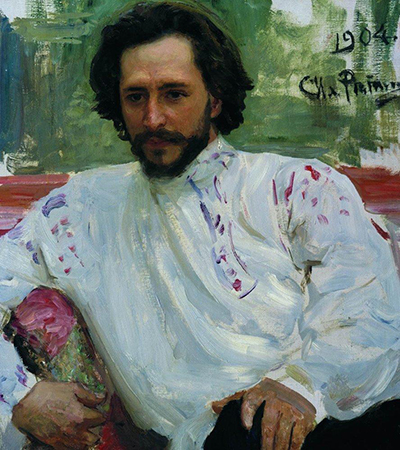Ilya Repin always strived in his work for depth and realism, and this portrait from 1904 is no exception. There were two portraits of Andreev, painted only months apart in the same year, and the likelihood is that Repin painted even more than that, along with hundreds of preliminary sketches.
Repin took time and used small brush strokes; he was motivated by a clearly defined sense of purpose. He was as committed to social realism as he was to visual realism within his art, and often utilised techniques including various hues of graphite pencils to convey increased distance, or shadows, or a certain mood. Within this painting, there is not much room for allegorical content.
Repin's depiction of an influential author recalls the vein of French Realists such as Gustave Courbet and going back to the eighteenth century, Chardin. These artists admired Impressionist techniques such as the conveyance of light and colour on to canvas, but adhered to the notion that only real life, tableaus of people and things living in minute detail, were designed to be painted. Courbet's works were characterised by encapsulating within brush or pencil strokes the precise engrossed expression on the face of L'homme à la pipe,and the exact gestures of the humans who were his subjects. After dinner at Ornans presents its viewer with a hand clenched over violin strings, whilst overstuffed guests slump cradling chins in hands.
Repin is similarly committed to the detail of his subject. This subject is Leonid Andreev, here depicted in his later middle years, whose notable works included "In the Fog" and "The Abyss." An important literary figure, Andreev was renowned for an acerbic sympathy with human suffering, a treatment of sex that left little to the admiration, and a profound pessimism that captures the ache of Modernism.
Ilya Repin has cleverly addressed all of these aspects to his subject's character. Andreev appears distracted, gazing into the middle distance, and the frown and furrows on the man's forehead are particularly distinct and suggestive of inner conflict. Repin has not flattered his model: Andreev's slightly receding hairline has not been omitted, though there is a suppressed energy and dynamism in the way the man's hand has been captured, clenched on the cushion he sits beside. Andreev has been immortalised clad in a loose white shirt of a style that calls to mind native peasants, with what is possibly blood red embroidery across the shoulders and collar allegorising conflict, a lack of peace.




